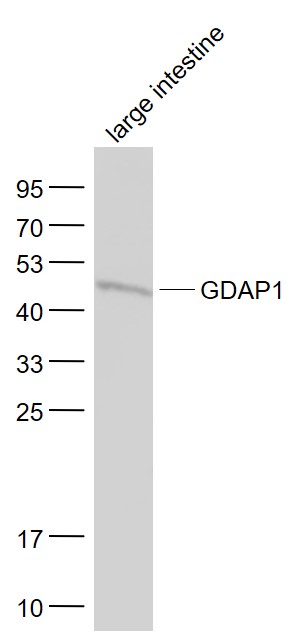
Rabbit Anti-GDAP1 antibody
Ganglioside induced differentiation associated protein 1; Ganglioside-induced differentiation-associated protein 1; GDAP1; GDAP1_HUMAN.
View History [Clear]
Details
Product Name GDAP1 Chinese Name 神经节苷脂诱导分化相关蛋白1抗体 Alias Ganglioside induced differentiation associated protein 1; Ganglioside-induced differentiation-associated protein 1; GDAP1; GDAP1_HUMAN. Research Area Cell biology Neurobiology Immunogen Species Rabbit Clonality Polyclonal React Species Mouse, (predicted: Human, Rat, Chicken, Dog, Pig, Cow, Horse, Rabbit, Sheep, ) Applications WB=1:500-2000 ELISA=1:5000-10000 IHC-P=1:100-500 IHC-F=1:100-500 ICC=1:100-500 IF=1:100-500 (Paraffin sections need antigen repair)
not yet tested in other applications.
optimal dilutions/concentrations should be determined by the end user.Theoretical molecular weight 41kDa Cellular localization cytoplasmic The cell membrane Form Liquid Concentration 1mg/ml immunogen KLH conjugated synthetic peptide derived from human GDAP1: 151-230/358 Lsotype IgG Purification affinity purified by Protein A Buffer Solution 0.01M TBS(pH7.4) with 1% BSA, 0.03% Proclin300 and 50% Glycerol. Storage Shipped at 4℃. Store at -20 °C for one year. Avoid repeated freeze/thaw cycles. Attention This product as supplied is intended for research use only, not for use in human, therapeutic or diagnostic applications. PubMed PubMed Product Detail Glutathione S-transferases (GSTs) function to conjugate reduced glutathione to many exogenous and endogenous hydrophobic electrophiles. Although it shares the carboxy and amino-terminal glutathione S-transferase domains, GDAP1 is characterized as a GST-like protein because it contains an extended GST domain II and a predicted transmembrane domain, two characteristics which are unusual for GST family members. GDAP1 may function in a signal transduction pathway that is responsible for ganglioside-induced neurite differentiation and also may play a role in protecting myelin membranes from free-radical damage. Mutations in the gene encoding GDAP1 is the cause of many forms of Charcot-Marie-Tooth disease, a common inherited disorder of the peripheral nervous system that is characterized by reduced nerve conduction velocities, slow progressive distal muscle atrophy and absent deep tendon reflexes.
Function:
May function in a signal transduction pathway responsible for ganglioside-induced neurite differentiation. May also have a role in protecting myelin membranes against free radical-mediated damage.
Subunit:
Homodimer.
Subcellular Location:
Mitochondrion outer membrane; Multi-pass membrane protein. Cytoplasm (By similarity).
Tissue Specificity:
Highly expressed in whole brain and spinal cord. Predominant expression in central tissues of the nervous system not only in neurons but also in Schwann cells.
DISEASE:
Defects in GDAP1 are the cause of Charcot-Marie-Tooth disease type 4A (CMT4A) [MIM:214400]. CMT4A is a form of Charcot-Marie-Tooth disease, the most common inherited disorder of the peripheral nervous system. Charcot-Marie-Tooth disease is classified in two main groups on the basis of electrophysiologic properties and histopathology: primary peripheral demyelinating neuropathy or CMT1, and primary peripheral axonal neuropathy or CMT2. Demyelinating CMT neuropathies are characterized by severely reduced nerve conduction velocities (less than 38 m/sec), segmental demyelination and remyelination with onion bulb formations on nerve biopsy, slowly progressive distal muscle atrophy and weakness, absent deep tendon reflexes, and hollow feet. Autosomal recessive forms of demyelinating Charcot-Marie-Tooth disease are by convention designated CMT4. CMT4A is a severe form characterized by early age of onset and rapid progression leading to inability to walk in late childhood or adolescence.
Defects in GDAP1 are the cause of Charcot-Marie-Tooth disease axonal recessive with vocal cord paresis (CMT2RV) [MIM:607706]. CMT2RV is a form of Charcot-Marie-Tooth disease characterized by the association of axonal neuropathy with vocal cord paresis.
Defects in GDAP1 are the cause of Charcot-Marie-Tooth disease type 2K (CMT2K) [MIM:607831]. CMT2K is an axonal form of Charcot-Marie-Tooth disease. Axonal CMT neuropathies are characterized by signs of axonal regeneration in the absence of obvious myelin alterations, normal or slightly reduced nerve conduction velocities, and progressive distal muscle weakness and atrophy. CMT2K onset is in early childhood (younger than 3 years). This phenotype is characterized by foot deformities, kyphoscoliosis, distal limb muscle weakness and atrophy, areflexia, and diminished sensation in the lower limbs. Weakness in the upper limbs is observed in the first decade, with clawing of the fingers. Inheritance can be autosomal dominant or recessive.
Defects in GDAP1 are the cause of Charcot-Marie-Tooth disease recessive intermediate type A (CMTRIA) [MIM:608340]. CMTRIA is a form of Charcot-Marie-Tooth disease characterized by clinical and pathologic features intermediate between demyelinating and axonal peripheral neuropathies, and motor median nerve conduction velocities ranging from 25 to 45 m/sec.
Similarity:
Belongs to the GST superfamily.
Contains 1 GST C-terminal domain.
Contains 1 GST N-terminal domain.
SWISS:
Q8TB36
Gene ID:
54332
Database links:
Entrez Gene: 54332 Human
Entrez Gene: 14545 Mouse
Omim: 606598 Human
SwissProt: Q8TB36 Human
SwissProt: O88741 Mouse
Unigene: 168950 Human
Unigene: 18218 Mouse
Product Picture
Bought notes(bought amounts latest0)
No one bought this product
User Comment(Total0User Comment Num)
- No comment



 +86 571 56623320
+86 571 56623320
 +86 18668110335
+86 18668110335

